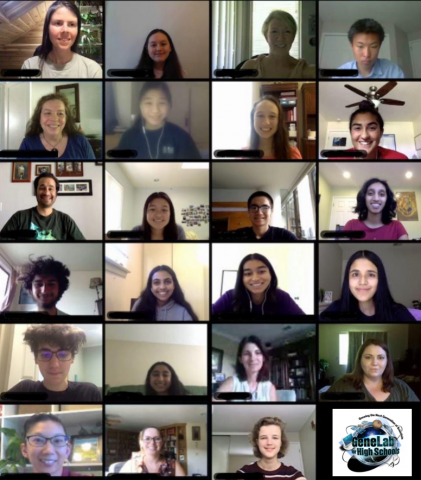
For the first time since it began three years ago, the GeneLab for High Schools (GL4HS) Program was held virtually and not on-site at NASA Ames Research Center due to COVID-19 restrictions. But for 15 high school interns from five states across the country, not being able to meet in person didn’t stop them from fully engaging in this space life sciences program established around omics-based bioinformatics research.
During the intensive four-week program, which ran from June 20 – July 17, 2020, students participated in a combination of science lectures and group activities that culminated in the creation of a competitive research proposal and an oral presentation of their findings. Lectures were given primarily by research scientist and program founder, Dr. Elizabeth Blaber, but also included several guest lectures from space biology experts from NASA and universities nationwide. The course materials were designed to teach students how space biology experiments are designed and carried out, with a focus on the generation of spaceflight omics data and how to process it.
To learn the entire process of data analysis, starting from raw files to annotated expression data, students used existing RNA-sequenced data collected from past spaceflight experiments, which are archived in the NASA GeneLab Data Repository. In addition, the GL4HS Bioinformatics Manual offered step-by-step instructions on how to analyze RNA-Seq data using the GeneLab Analysis Platform. Student learned how to perform quality control on data, align sequencing data, count transcripts, and perform differential gene expression analysis. Once the students annotated and examined the gene expression data, they used gene-set enrichment and gene ontology tools to perform pathway analysis. From this, they formed hypotheses and designed further experiments that are intended to build on gene expression patterns they discovered from the data.
Working virtually in small groups, the students analyzed five different tissues from NASA’s Rodent Research 6 mission. They designed experiments to study the effects of microgravity in ground-based facilities, utilizing available tools such as simulated microgravity devices to grow cells, or by accessing tissues from past spaceflight missions stored in NASA’s Life Sciences Data Archive. Their research proposals are currently under evaluation for scientific merit and feasibility. A panel of experts will select one group to travel to Ames Research Center in 2021 to carry out their proposed experiments in the lab.
To learn more about the GeneLab for High Schools Program, send email to:

